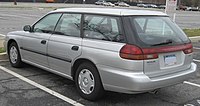Subaru Legacy (second generation)
Second generation (1993-1999)
| Second generation | |
|---|---|
 | |
| Overview | |
| Production | 1993-1999 |
| Body and chassis | |
| Body style | "B" pillar Hardtop and Wagon |
| Layout | FF layout '95 standard F4 layout '95 optional, '96 & up, standard |
| Related | Subaru Outback |
| Powertrain | |
| Engine | 2.0 L SOHC 115 hp (86 kW) H4 2.0 L DOHC 150 hp (110 kW) H4 |
| Transmission | 4-speed automatic 5-speed manual |
| Dimensions | |
| Wheelbase | 103.5 in (2,630 mm) |
| Length | 1995-97 Sedan: 180.9 in (4,590 mm) 1998-99 Sedan: 181.5 in (4,610 mm) 1998-99 Wagon: 184.5 in (4,690 mm) 1995-96 Wagon: 183.9 in (4,670 mm) |
| Width | 67.5 in (1,710 mm) |
| Height | Wagon: 57.1 in (1,450 mm) 2.5GT Wagon: 60.3 in (1,530 mm) Sedan: 55.3 in (1,400 mm) 2.5GT Sedan: 55.7 in (1,410 mm) |
| Curb weight | 3,135 lb (1,422 kg) max |
- Chassis code
- BD - sedan
- BG - wagon - standard roof
- BK - wagon - extended roof

Second generation sales in Japan began with model year 1993, and 1995 marked the second generation in North America with a full body and chassis revision. The exterior was designed by Olivier Boulay, who was hired by Subaru on a short-term basis. The tail light appearance on both the sedan and wagon was influenced by the taillights on the SVX. In 1996, Subaru decided to make AWD standard equipment in all vehicles produced for the USA market from that year to today's current date. Subaru still offers a choice between FWD and AWD for its domestic market vehicles.
GT models, first offered as a wagon trim package for the USA version in 1994, became a full-blown upgrade in 1996, using the new DOHC 2.5 L engine. GT models continue to the present model, with Limited editions available, offering heated leather, or cloth, seats and trim and a tinted, glass moonroof. Driver and front passenger airbags were added with the redesigned interior. New equipment added to the list of features included RF remote keyless entry, fog lights on the upper trim levels and speed-sensitive power steering.
The remote keyless entry can unlock just the drivers door by pushing the unlock button once, with two pushes unlocking all doors. Using the key to unlock the door after using the remote keyless entry to lock the doors will cause the alarm to sound, if equipped with a security system. The doors must be unlocked with the remote to avoid the security system from being set off.
1999 Marked the 30th anniversary of Subaru, and the last of the second generation in North America. There was a special 30th Anniversary Edition offered with upgraded interior and sunroof, spoiler, alloy wheels on the "L" trim level cars. The Brighton trim level also carried over from the facelifted first generation version that was priced below the "L" trim option. The "GT" trim level appeared in 1996. The term "Limited" appeared on the "GT", known as the "GT Limited" in 1998. The term "Limited" was used by itself on the Outback in 1998.
In Japan, the GT-B was introduced June 1996 with the front and rear struts supplied by Bilstein [1], with the upgrade also available on the RS. The "B" designation stood for Bilstein. The GT-B can also be distinguished by upgraded projector beam headlight lenses.
A unusual interior change placed the power window switches flat against the door panel, whereas the window switches for the first generation and third generation extended from the door panels and were oriented in a horizontal position and were located underneath the drivers or occupants hands for easy location and use, and integrated into the door pull and armrest. The express up feature for the driver's window was also removed, leaving express down only. The power door lock switch design was upgraded to a more conventional door lock switch, installed next to the power window switches, with a secondary power lock switch installed for the front passenger.
Side turn signal repeater lenses that were introduced on the USA 1992-1994 Legacy were replaced by a plastic cap that matched the color of the door rub strip on vehicles sold in North America.
According to the French Wikipedia, LPG is introduced as an alternative fuel source on European models with the 2.0 L and 2.2 L engines, and are outfitted by company Necam Koltec. The fuel tank is installed in the spare tire compartment, with the spare tire installed vertically on the left side of the trunk or cargo area.
Legacy RS Twin Turbo

Turbocharged versions continued to be available in most non-US markets. Specialty touring and racing versions were available in Japan, as well as the DOHC 2 liter twin sequential turbocharged (EJ20H) version on both the Legacy RS sedan and wagon, listed as "Boxer 2-stage Twin Turbo" on the engine cover shroud. The twin turbo can only be installed on right-hand drive vehicles because the turbo on the left side interferes with both the brake master cylinder and steering linkage, among other things. A minor performance problem with the twin turbo is there was a "turbo dead zone" that surfaced between the transition from the first turbo before the second turbo would kick in around 3500-4000 rpm. A continuous traction delivery system, called VTD by Subaru, was used with all JDM turbocharged vehicles with the automatic transmission. The VTD AWD system is a permanent AWD due to its 36% / 64% split.
Head gasket issues
Some owners of the newly developed 2.5 L engine for this generation have experienced leaking head gasket issues, which were addressed and much improved on the Third Generation models.
